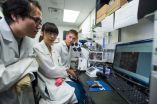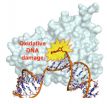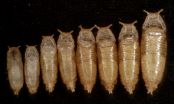INFORMATION:
The research is supported by the National Institutes of Health and by UB's Arthur A. Schomburg Fellowship Program.
A hybrid vehicle that delivers DNA
The new transport system for DNA vaccines could help treat HIV, malaria and other major illnesses
2014-11-25
(Press-News.org) BUFFALO, N.Y. - A new hybrid vehicle is under development.
Its performance isn't measured by the distance it travels, but rather the delivery of its cargo: vaccines that contain genetically engineered DNA to fight HIV, cancer, influenza and other maladies.
Described recently in the Proceedings of the National Academy of Sciences, the technology is a biomedical advancement that could help unleash the potential of DNA vaccines, which despite two decades of research, have yet to make a significant impact in the treatment of major illnesses.
"The technology that we're developing could help take immunization to the next level," said Blaine A. Pfeifer, PhD, an associate professor in the Department of Chemical and Biological Engineering in the School of Engineering and Applied Sciences at the University at Buffalo.
Pfeifer, the study's lead author, added: "By improving the delivery of DNA vaccines, we can potentially harness the human immune system in new ways to fight everything from the flu and herpes to HIV and cancer."
Conventional vaccines, like those used to fight polio and smallpox, are typically composed of an agent that contains weakened or killed forms of the disease-causing microbe. The agent prompts the immune system to recognize the agent as foreign, destroy it, and keep a record of it so the immune system can more effectively fight it in the future.
While effective, some vaccines don't last, others can revert to dangerous forms and some are costly and time-consuming to develop. Furthermore, no effective vaccines exist for cancer, malaria and others diseases that kill millions of people worldwide annually.
DNA vaccines could address these problems.
To create them, researchers analyze disease-causing sources, such as a pathogenic microbe. They then isolate copies of the microbe's genes (usually one or two) responsible for the disease.
The genetically engineered DNA is injected into the body, whereupon being processed by the immune cells, directs the production and presentation of antigens which provoke an adaptive immune response capable of destroying the disease.
Essentially, the body's own cells become vaccine-making factories that create the antigens necessary to stimulate the immune system, according to the National Institute of Allergy and Infectious Diseases.
In theory, DNA vaccines can generate broad immune responses; they are relatively inexpensive to create; and they can't cause the disease because they don't contain the source of the disease, only a few of its genes. Dozens of clinical trials involving DNA vaccines are underway. Most are investigating treatments for HIV and cancer, while others involve influenza, hepatitis B and C, HPV and malaria.
A problem limiting the effectiveness of some DNA vaccines, however, is that they do not sufficiently stimulate the immune system. Scientists say this is due, in part, to the inefficient delivery of the genes. For example, some travel to the wrong place while others get caught in intracellular traffic jams.
To address the problem, Pfeifer and his students collaborated with Anders Hakansson, PhD, formerly of the UB School of Medicine and Biomedical Sciences, and a senior co-author of the study.
The team combined two delivery vehicles - a bacterial cell and a synthetic polymer - to create a hybrid. Designed to target specific immune cells (antigen-presenting cells) and more efficiently deliver genes to the nucleus of those cells, the hybrid outperformed the two individual delivery vehicles when tested in a mouse model.
"The hybrid provided a synergistic boost in delivery effectiveness due to its dual nature," said Charles H. Jones, a doctoral candidate in the Department of Chemical and Biological Engineering at UB and the study's first author. "We also determined that it's relatively inexpensive to create and flexible in terms of use. The results thus far are very encouraging."
The team continues to test the vehicle in different models. The goal, Pfeifer said, is to create a vehicle that will be useful for many DNA vaccines.
ELSE PRESS RELEASES FROM THIS DATE:
Pathology specialist contributes to debate on breast cancer gene screening
2014-11-25
There has been much recent debate on the benefits and risks of screening for breast cancer using BRCA1 and BRCA2 mutations in the general adult population. With an estimated 235,000 new breast cancer diagnoses each year in the U.S. and more than 40,000 deaths, it is clearly important to be able to determine which women may be genetically predisposed to breast cancer.
Glenn E. Palomaki, PhD, associate director of the Division of Medical Screening and Special Testing in the Department of Pathology and Laboratory Medicine at Women & Infants Hospital of Rhode Island has ...
Study supports free 'super Wi-Fi'
2014-11-25
This news release is available in German.
Wireless data transmission largely takes place via WLAN networks, such as WiFi. However, these networks are currently limited to high frequency ranges at 2 GHz and above and, hence, have a limited range. The authors of the study, Arnd Weber of the Institute for Technology Assessment and Systems Analysis (ITAS) of KIT and Jens Elsner, a former member of the staff of the KIT Communications Engineering Lab, propose to extend the frequencies for free communication to include lower ranges and even increased transmission power. ...
Athletes' testosterone surges not tied to winning, study finds
2014-11-25
A higher surge of testosterone in competition, the so-called "winner effect," is not actually related to winning, suggests a new study of intercollegiate cross country runners.
The International Journal of Exercise Science published the research, led by David Edwards, a professor of psychology at Emory University, and his graduate student Kathleen Casto.
"Many people in the scientific literature and in popular culture link testosterone increases to winning," Casto says. "In this study, however, we found an increase in testosterone during a race regardless of the athletes' ...
Mining can damage fish habitats far downstream, study shows
2014-11-25
Anglers across the nation wondering why luck at their favorite fishing spot seems to have dried up may have a surprising culprit: a mine miles away, even in a different state.
Scientists at Michigan State University (MSU) have taken a first broad look at the impacts of mines across the country- and found that mining can damage fish habitats miles downstream, and even in streams not directly connected to the mines.
The work is published in this week's issue of the journal Ecological Indicators.
"We've been surprised that even a single mine in headwaters might influence ...
Incomes fall as stressed economy struggles
2014-11-25
Australian average incomes are falling with the country's population growth "masking underlying economic weakness", according to a QUT economist.
Dr Mark McGovern, a senior lecturer in QUT's Business School, said while it was regularly proclaimed Australia had experienced positive economic growth for more than 20 years, there had been periodic per capita declines, indicating the economy was not as healthy as assumed.
"Looking at national income figures in recent years shows our economy is under stress," Dr McGovern, whose research was recently published in the Economic ...
Circumstances are right for weed invasion to escalate, researchers say
2014-11-25
Few agribusinesses or governments regulate the types of plants that farmers use in their pastures to feed their livestock, according to an international team of researchers that includes one plant scientist from Virginia Tech.
The problem is most of these so-called pasture plants are invasive weeds.
In a Proceedings of the National Academy of Sciences study this month, the scientists recommended tighter regulations, including a fee for damage to surrounding areas, evaluation of weed risk to the environment, a list of prohibited species based on this risk, and closer ...
NIH scientists determine how environment contributes to several human diseases
2014-11-25
Using a new imaging technique, National Institutes of Health researchers have found that the biological machinery that builds DNA can insert molecules into the DNA strand that are damaged as a result of environmental exposures. These damaged molecules trigger cell death that produces some human diseases, according to the researchers. The work, appearing online Nov. 17 in the journal Nature, provides a possible explanation for how one type of DNA damage may lead to cancer, diabetes, hypertension, cardiovascular and lung disease, and Alzheimer's disease.
Time-lapse crystallography ...
Study maps how city neighborhoods affect diabetes risk
2014-11-25
PHILADELPHIA (Nov. 25, 2014) - As the linked epidemics of obesity and diabetes continue to escalate, a staggering one in five U.S. adults is projected to have diabetes by 2050.
Ground zero for identifying ways to slow and stop that rise is Philadelphia, which has the highest diabetes rate among the nation's largest cities. For public health researchers at Drexel University, it is also a prime location to learn how neighborhood and community-level factors -- not just individual factors like diet, exercise and education-- influence people's risk.
A new Drexel study published ...
International team reveals barriers to public health data-sharing; life-saving solutions
2014-11-25
PITTSBURGH, Nov. 24, 2014 -Barriers to the sharing of public health data hamper decision-making efforts on local, national and global levels, and stymie attempts to contain emerging global health threats, an international team led by the University of Pittsburgh Graduate School of Public Health announced today.
The analysis, published in the journal BMC Public Health and funded by the Bill & Melinda Gates Foundation and the National Institutes of Health (NIH), classifies and examines the barriers in order to open a focused international dialogue on solutions.
"Data on ...
Body size requires hormones under control
2014-11-25
The proper regulation of body size is of fundamental importance, but the mechanisms that stop growth are still unclear. In a study now published in the scientific journal eLife*, a research group from Instituto Gulbenkian de Ciência (IGC), led by Christen Mirth, shed new light on how animals regulate body size. The researchers uncovered important clues about the molecular mechanisms triggered by environmental conditions that ultimately affect final body size. They show that the timing of synthesis of a steroid hormone called ecdysone is sensitive to nutrition in the ...
LAST 30 PRESS RELEASES:
Boosting the cell’s own cleanup
Movement matters: Light activity led to better survival in diabetes, heart, kidney disease
Method developed to identify best treatment combinations for glioblastoma based on unique cellular targets
Self-guided behavioral app helps children with epilepsy sleep earlier
Higher consumption of food preservatives is associated with an increased risk of type 2 diabetes
NTU Singapore-led team captures first-ever ‘twitch’ of the eye’s night-vision cells as they detect light, paving the way for earlier detection of blindness-causing diseases
Global aviation emissions could be halved through maximising efficiency gains, new study shows
Fewer layovers, better-connected airports, more firm growth
Exposure to natural light improves metabolic health
As we age, immune cells protect the spinal cord
New expert guidance urges caution before surgery for patients with treatment-resistant constipation
Solar hydrogen can now be produced efficiently without the scarce metal platinum
Sleeping in on weekends may help boost teens’ mental health
Study: Teens use cellphones for an hour a day at school
After more than two years of war, Palestinian children are hungry, denied education and “like the living dead”
The untold story of life with Prader-Willi syndrome - according to the siblings who live it
How the parasite that ‘gave up sex’ found more hosts – and why its victory won’t last
When is it time to jump? The boiling frog problem of AI use in physics education
Twitter data reveals partisan divide in understanding why pollen season's getting worse
AI is quick but risky for updating old software
Revolutionizing biosecurity: new multi-omics framework to transform invasive species management
From ancient herb to modern medicine: new review unveils the multi-targeted healing potential of Borago officinalis
Building a global scientific community: Biological Diversity Journal announces dual recruitment of Editorial Board and Youth Editorial Board members
Microbes that break down antibiotics help protect ecosystems under drug pollution
Smart biochar that remembers pollutants offers a new way to clean water and recycle biomass
Rice genes matter more than domestication in shaping plant microbiomes
Ticking time bomb: Some farmers report as many as 70 tick encounters over a 6-month period
Turning garden and crop waste into plastics
Scientists discover ‘platypus galaxies’ in the early universe
Seeing thyroid cancer in a new light: when AI meets label-free imaging in the operating room
[Press-News.org] A hybrid vehicle that delivers DNAThe new transport system for DNA vaccines could help treat HIV, malaria and other major illnesses






